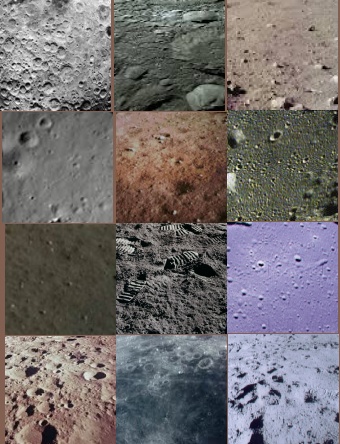It looks like you're using an Ad Blocker.
Please white-list or disable AboveTopSecret.com in your ad-blocking tool.
Thank you.
Some features of ATS will be disabled while you continue to use an ad-blocker.
share:
a reply to: wildespace
Unsubstantiated statement.
You've simply been told about, otherwise you 'd never say so like every person, predominantly children, I asked.
Without power telescope, of course.
NO!
It's just an illusion caused, except for lack of illumination, partly with absence of colorimetric scale, like so called 'Apollo gnomon', close by the Moon.
A similar to this is an effect of 'huge Moon' near horizon and small one up in the sky while its angle dimention remains the same.
Your own example of such kind of sudden effects
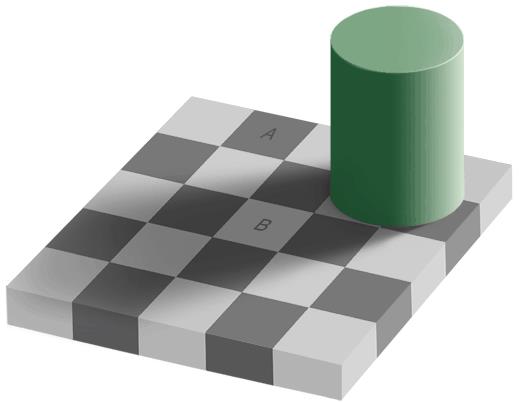
www.facebook.com...#
witnesses it expressively too.
And at last the objective data obtained repeatedly long ago at pre-Apollo times, like that one I posted before
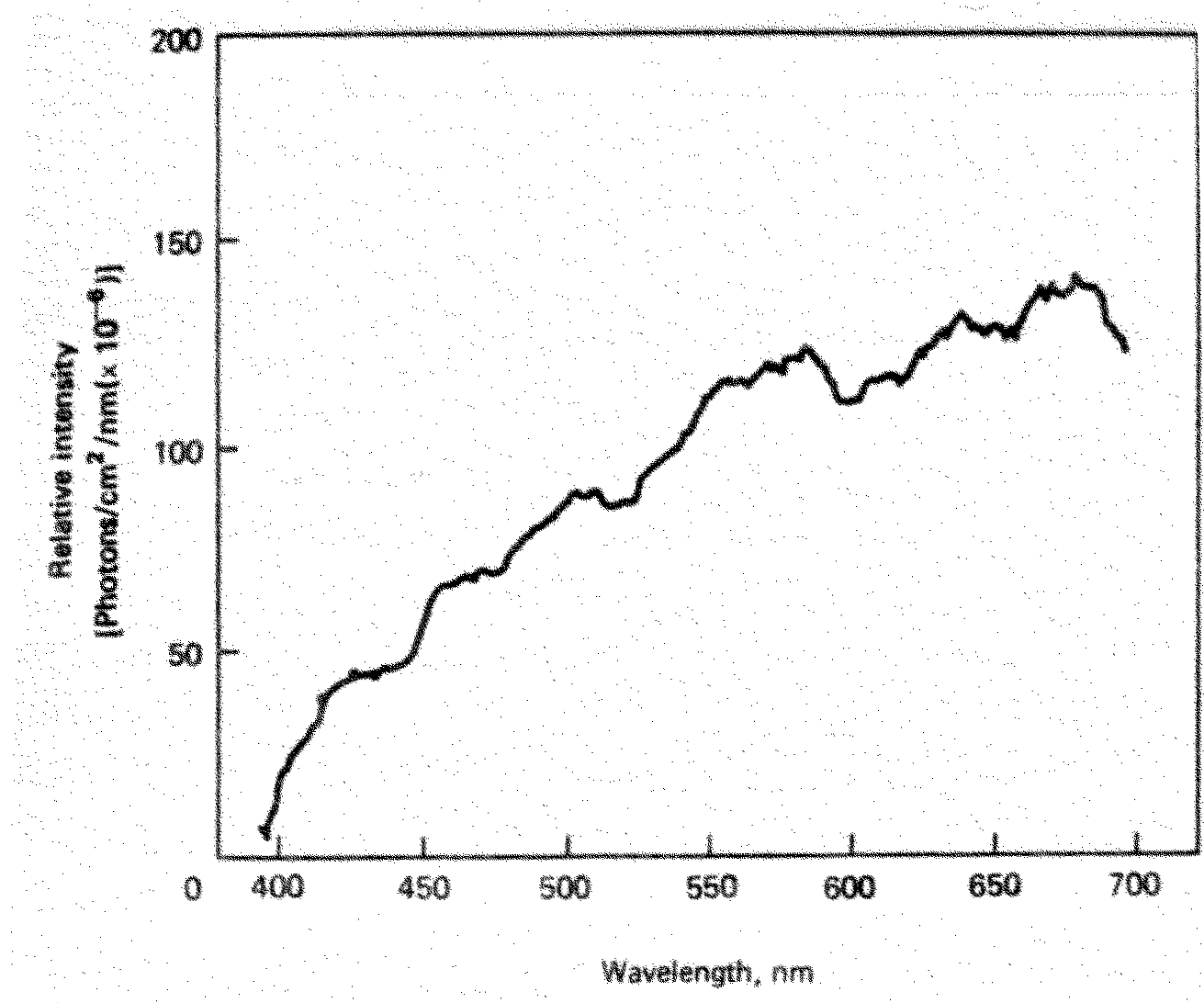
don't confirm this 'grey Moon' version nowise.
By the way, it is essential to you to pay an attention to observation conditions of that case
This means that your previous allegation
proved to be unfounded too.
My congratulations!
Thanks! I'm gonna thik about it.
...the brightness of the Moon is certainly bright enough to activate cone cells.
Unsubstantiated statement.
Even stars are bright enough for this, as red and orange stars like Aldebaran or Arcturus can be easily observed as such.
You've simply been told about, otherwise you 'd never say so like every person, predominantly children, I asked.
Without power telescope, of course.
The Moon is mostly dark-grey...
NO!
It's just an illusion caused, except for lack of illumination, partly with absence of colorimetric scale, like so called 'Apollo gnomon', close by the Moon.
A similar to this is an effect of 'huge Moon' near horizon and small one up in the sky while its angle dimention remains the same.
Your own example of such kind of sudden effects

www.facebook.com...#
witnesses it expressively too.
And at last the objective data obtained repeatedly long ago at pre-Apollo times, like that one I posted before

don't confirm this 'grey Moon' version nowise.
By the way, it is essential to you to pay an attention to observation conditions of that case
The spectrum of moon light, recorded at Eniwetok, 0200 hr., August 20, 1970. The moon was 15° from zenith. Note that the spectrum peaks near 660 nm.
www.biog1445.org...
This means that your previous allegation
That looks like the result of atmospheric influence when the Moon is low on the horizon.
proved to be unfounded too.
My congratulations!
I run a Facebook group dedicated to this topic, please feel free to join: Colour of the Moon.
Thanks! I'm gonna thik about it.
edit on 16-4-2015 by viewer740 because: more picture insert
originally posted by: viewer740
a reply to: wildespace
...the brightness of the Moon is certainly bright enough to activate cone cells.
Unsubstantiated statement.
How so? The Moon has reflecity of asphalt, but it is bathed in the very bright sunlight. You can see the Moon during the day too. Have you ever looked at asphalt on a sunny summer day? The asphalt is bright enough that you'd want to wear sunglasses when you look at it.
Even stars are bright enough for this, as red and orange stars like Aldebaran or Arcturus can be easily observed as such.
You've simply been told about, otherwise you 'd never say so like every person, predominantly children, I asked.
Without power telescope, of course.
No, I have seen it with my own eyes. Betelgeuse, Aldebaran, Arcturus, and a few other stars are distinctly orange. Mars appears reddish, despite being much dimmer than the Moon.
I'm sorry, but you're talking nonsense, and accusing me of nonsense too.
wildespace...the brightness of the Moon is certainly bright enough to activate cone cells.
viewer740...Unsubstantiated statement.
The full moon is bright enough for people on earth to be able to read by moonlight, and can casts a substantial shadow.
wildespace...Even stars are bright enough for this, as red and orange stars like Aldebaran or Arcturus can be easily observed as such.
viewer740...You've simply been told about, otherwise you 'd never say so like every person, predominantly children, I asked.
Without power telescope, of course.
I don't know about all children, but when I was younger, I know for a fact that I could see that some stars looked reddish, just like I can see those reddish stars today.
My older brother was always a bit of an amateur astronomer and stargazer, and I remember him telling me (when I was young) how to find some of the stars. He mentioned the stargazers adage "follow the arc to Arcturus", which means following the arc in the handle of the Big Dipper to find the star Arcturus. I remember noticing how orange Arcturus was. I didn't need to be told it was orange, because i can see with my own naked eye that it was orange.
Go out and look for yourself and see reddish-orange Arcturus. As wildspace mentioned, look at Betelgeuse with your own eyes (although it's getting harder to see as we head towards spring and summer, with Orion being more of a winter Constellation). Look at Aldebaran (again, mostly in the fall and winter night sky). It doesn't take a telescope to see reddish or orangish stars. There are several out there that are visibly orange-red when viewed with the naked eye.
edit on 4/16/2015 by Soylent Green Is People because: (no reason given)
a reply to: wildespace
Few others I believe means not more than dozen items while about 1.5-2 thousand stars can be seen at night with naked eye.
Altogether about 0.6-0.8% - nearly nothing of coloured stars amount.
No, no! Bla-bla-bla doesn't fit at all! Mesopic vision, Purkinje effect, luminances and sensitivity levels... - these could be reason.
And while...
Astronomer N.N.Sytinskaya ('Nature of the Moon' 1959)
docs.google.com...

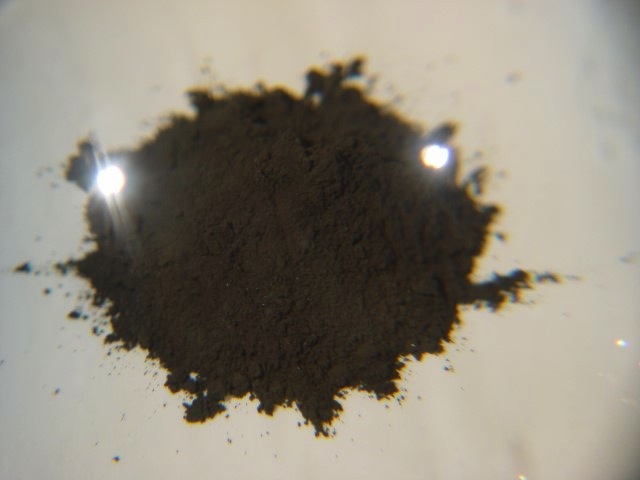
Need in translation? I suspect no.
I have seen it with my own eyes. Betelgeuse, Aldebaran, Arcturus, and a few other stars are distinctly orange...
Few others I believe means not more than dozen items while about 1.5-2 thousand stars can be seen at night with naked eye.
Altogether about 0.6-0.8% - nearly nothing of coloured stars amount.
The Moon has reflecity of asphalt, but it is bathed in the very bright sunlight. You can see the Moon during the day too. Have you ever looked at asphalt on a sunny summer day? The asphalt is bright enough that you'd want to wear sunglasses when you look at it.
No, no! Bla-bla-bla doesn't fit at all! Mesopic vision, Purkinje effect, luminances and sensitivity levels... - these could be reason.
And while...
Astronomer N.N.Sytinskaya ('Nature of the Moon' 1959)
docs.google.com...


Need in translation? I suspect no.
edit on 16-4-2015 by viewer740 because: text editing
edit on 16-4-2015 by viewer740
because: picture insert
a reply to: viewer740
Perhaps the results of the reflectivity measurements are due to the iron-rich areas on the Moon which have orange-ish hue. In any case, I don't see how you can equate a slight variation in the reflectivity spectra with such a pronounced and vivid brown which you want us to belive to be the real colour of the Moon. All kinds of minerals reflect certain wavelengths more than others, but that doesn't mean there are no grey rocks in nature.
Tell me this, if so much scientific literature documents that the Moon is brown, why aren't scientists speaking out against the depictions of the Moon as grey? Perhaps it's because their measurements have never been intended to be interpreted that way.
Perhaps the results of the reflectivity measurements are due to the iron-rich areas on the Moon which have orange-ish hue. In any case, I don't see how you can equate a slight variation in the reflectivity spectra with such a pronounced and vivid brown which you want us to belive to be the real colour of the Moon. All kinds of minerals reflect certain wavelengths more than others, but that doesn't mean there are no grey rocks in nature.
Tell me this, if so much scientific literature documents that the Moon is brown, why aren't scientists speaking out against the depictions of the Moon as grey? Perhaps it's because their measurements have never been intended to be interpreted that way.
a reply to: wildespace
Real colour of the Moon is not too vivid brown but distinctly non-grey.
This well known fact became a subject for dispute after Surveyor sent back color picture with wrong selected triad of colour filters (Orange instead of Red)
www.aulis.com...
www.leonidkonovalov.ru...
Point of view that 'newer data' is always better than elder one, prevailed at last. That stagger inter alia reflected as ridiculous jumps of Moon surface colour on mission insignias, I posted higher.
Concerning differing colours of minerals - remember your own childhood when you got the first expirience in colour mixing and decided to get the most amazing SUPER-R-R-R result by mixing together all water-colour paints you had. Do you ?
So like we all eat food of many various colour but at the output we could have only the same old tint. Нуты понел.
Prostitute position of some kind of scientists I don't even want to mention. Unfortunately just they sometimes determine the face of science.
Real colour of the Moon is not too vivid brown but distinctly non-grey.
This well known fact became a subject for dispute after Surveyor sent back color picture with wrong selected triad of colour filters (Orange instead of Red)
www.aulis.com...
www.leonidkonovalov.ru...
Point of view that 'newer data' is always better than elder one, prevailed at last. That stagger inter alia reflected as ridiculous jumps of Moon surface colour on mission insignias, I posted higher.
Concerning differing colours of minerals - remember your own childhood when you got the first expirience in colour mixing and decided to get the most amazing SUPER-R-R-R result by mixing together all water-colour paints you had. Do you ?
So like we all eat food of many various colour but at the output we could have only the same old tint. Нуты понел.
Prostitute position of some kind of scientists I don't even want to mention. Unfortunately just they sometimes determine the face of science.
a reply to: wildespace
Yea I got a picture with the actual color of the Moon.
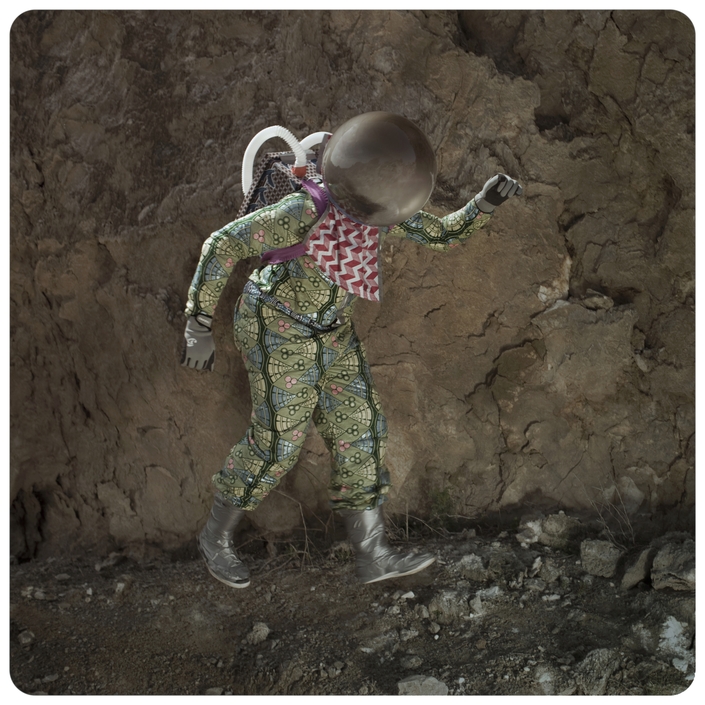
but the glass of Armstrong helmet just misted over.
Yea I got a picture with the actual color of the Moon.

but the glass of Armstrong helmet just misted over.
edit on 17-4-2015 by viewer740 because: text correction
Why should NASA suppress the real color of the Moon? There are petabytes of Apollo mission photos. How would they strip out color of the Moon's
surface, but leave all artifacts brought to the Moon by the Apollo astronauts their vivid real colors? They didn't have Photoshop in the 1970's, and
as I said, there were petabytes of photos to alter. The photos were analyzed by independent laboratories worldwide (many who downloaded the original
photos from NASA's server and analyzed them without NASA's knowledge).
originally posted by: wildespace
Here's a colour photo of the The Aristarchus Plateau, by Russell Croman
Normally, we think of the moon as fairly colorless, especially in comparison to the Earth. But the moon is not entirely without color, as this image of the Aristarchus Plateau region shows. The plateau itself is the roughly rectangular brownish region at the center of the picture. It is punctuated by the bright young crater Aristarchus, and the older, lava-filled crater Herodotus. The feature starting to the right of Herodotus and meandering across the plateau is Schroter's Valley, possibly a collapsed lava tube or ancient lava flow. The plateau apparently gets its color from an iron-rich material spewed out onto it by volcanic activity.
I've read that you can see this brown colouration through a telescope with your own eyes.
I'd like to post an "update" on this, because I have looked at the Moon through my 10x42 binoculars, keeping them very steady against the window frame, and paid special attention to the Aristarchus plateau. It appears distinctly orange-ish/yellow-ish. I encourage everyone who owns a good pair of binoculars to repeat this observation.
~~~
Not sure I have shared the link here yet, but I run a Facebook group about the colours of the Moon, where you can find lots more images and information: www.facebook.com...
a video I made two days ago:
totally yellow-ish/brown-ish in the second part of the video.... because i used higher magnification indeed. In the first part I used shorter magnification, and it appears as grey as when we look it with naked eye...
totally yellow-ish/brown-ish in the second part of the video.... because i used higher magnification indeed. In the first part I used shorter magnification, and it appears as grey as when we look it with naked eye...
The recently-released Apollo image archive at Flickr (and having found out that I can access those images are the
Gateway to Astronaut Photography) allowed me to come across this colour photo, taken from lunar orbit during the
Apollo 17 mission: AS17-151-23217.
Straight away, I could notice that there's some varying colouration to the lunar surface, with some familiar dark-bluish and lighter-reddish hues.
Here's this image enhanced by me:

(In case anyone's wondering, the crater seen here is Clerke crater, located near the eastern edge of Mare Serenitatis and not far from the landing site of Apollo 17)
Straight away, I could notice that there's some varying colouration to the lunar surface, with some familiar dark-bluish and lighter-reddish hues.
Here's this image enhanced by me:

(In case anyone's wondering, the crater seen here is Clerke crater, located near the eastern edge of Mare Serenitatis and not far from the landing site of Apollo 17)
In my Colour of the Moon Facebook group, there's a growing amount of contributions from
people taking colour images of the Moon, like this one
taken with a DSLR attached to a telescope:
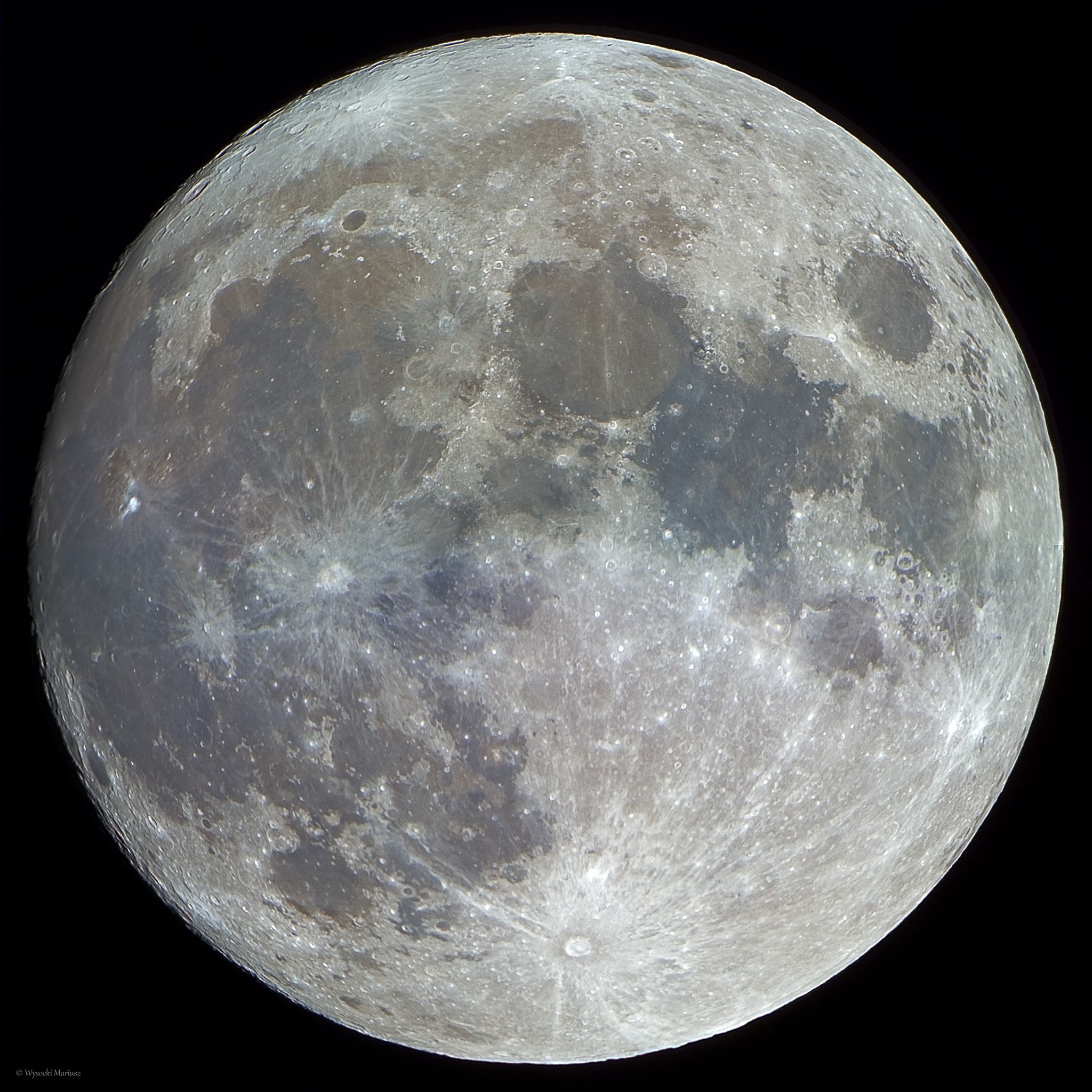
But one guy not only produces detailed telescopic photos like this one:
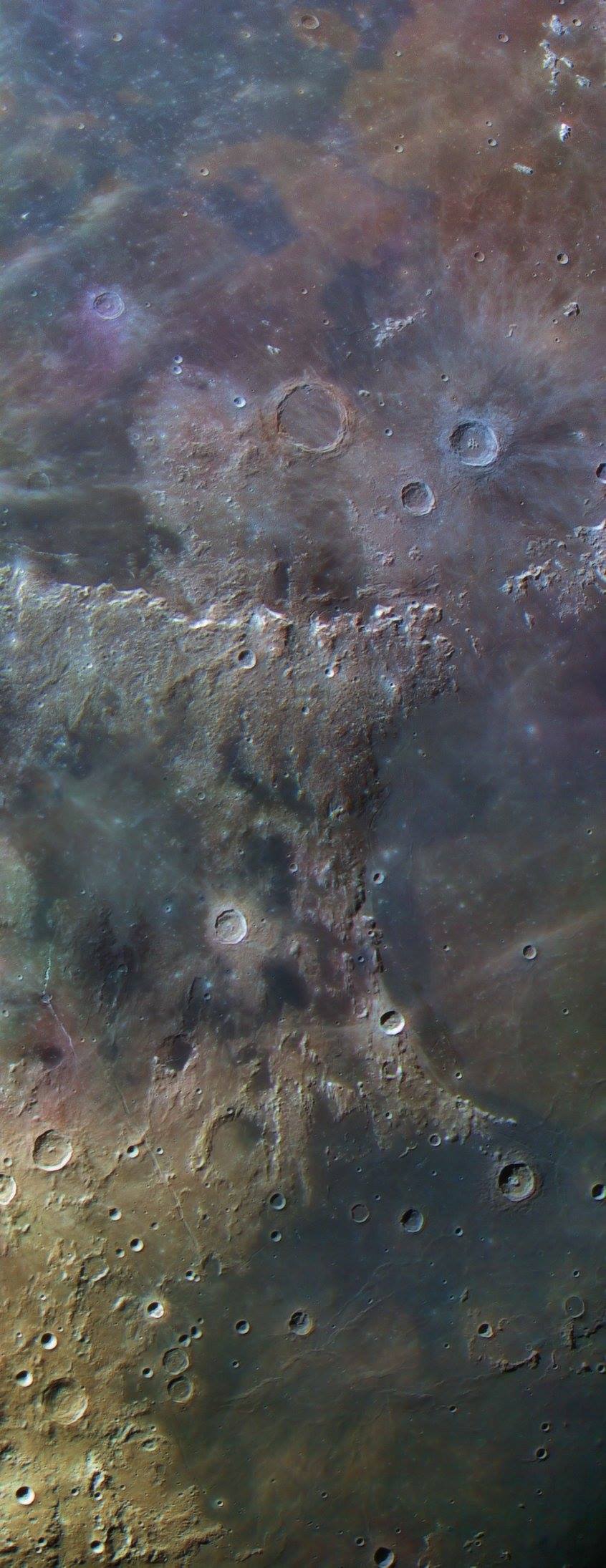
but also makes virtual flyover videos using his images overlayed on 3D terrain map:
www.youtube.com...
Wow! Incredible to see with your own eyes that the Moon is such a patchwork of different colours, when they are enhanced. There are not only the usual reddish and bluish hues, but also pink and yellow, corresponding (if I'm not mistaken) to aluminum-rich feldspars and olivine, respectively. Those colours are most visible in the lunar highlands, especially around Tycho crater.

But one guy not only produces detailed telescopic photos like this one:

but also makes virtual flyover videos using his images overlayed on 3D terrain map:
www.youtube.com...
Wow! Incredible to see with your own eyes that the Moon is such a patchwork of different colours, when they are enhanced. There are not only the usual reddish and bluish hues, but also pink and yellow, corresponding (if I'm not mistaken) to aluminum-rich feldspars and olivine, respectively. Those colours are most visible in the lunar highlands, especially around Tycho crater.
Leave NASA's composite pictures alone, you heretic. How dare you brighten or raise the exposure:

www.abovetopsecret.com...

www.abovetopsecret.com...
edit on 14-1-2017 by Kromlech because: (no reason given)
Another fantastic 3D flyover over the colourful Moon:
www.youtube.com...
WOW
And all of a sudden I'm wondering why is there such a prominent concentration of iron-poor, titanium-rich minerals in Mare Tranquilitatis (the dark blue area), and such large concentration of irocn-rich minerals elsewhere.
www.youtube.com...
WOW
And all of a sudden I'm wondering why is there such a prominent concentration of iron-poor, titanium-rich minerals in Mare Tranquilitatis (the dark blue area), and such large concentration of irocn-rich minerals elsewhere.
edit on 17-1-2017 by wildespace because: (no reason given)
originally posted by: Saint Exupery
a reply to: Kromlech
Oh look! Someone else who thinks that playing with PS sliders makes them a photoanalyst has discovered digital compression artifacts!
By the way, that's not a NASA image, nor did it come from an American spacecraft.
Hence a COMPOSITE -- CGI -- like your avatar.
edit on 17-1-2017 by Kromlech because: (no reason given)
originally posted by: Kromlech
originally posted by: Saint Exupery
a reply to: Kromlech
Oh look! Someone else who thinks that playing with PS sliders makes them a photoanalyst has discovered digital compression artifacts!
By the way, that's not a NASA image, nor did it come from an American spacecraft.
Hence a COMPOSITE -- CGI -- like your avatar.
Or like photos you take with your camera. Or like everything you see on your TV screen. Every colour electronic image is a kind of composite. BTW, "CGI" stands for computer-generated imagery. In our modern day and age, is it a wonder that practically all of imagery is created and/or processed using computers? It's called technological progress, friend.
But I gotta correct Saint Exupery. That image is indeed from NASA, taken by LRO: www.huffingtonpost.com... Although it does look like something taken by the Japanese Hayabusa spacecraft.
edit on 17-1-2017 by wildespace because: (no reason given)
originally posted by: wildespace
But I gotta correct Saint Exupery. That image is indeed from NASA, taken by LRO: www.huffingtonpost.com... Although it does look like something taken by the Japanese Hayabusa spacecraft.
I stand corrected. However, if I may correct your correction, it actually looks like something taken by the Japanese Kaguya (SELENE) spacecraft, not the Hayabusa probe.
edit on 18-1-2017 by Saint Exupery because: Corrected link
"Fly me to the Moon"
The aforementioned guy created his best flyover video to date, again using his saturation-enhanced telescopic images over a 3D terrain model: www.youtube.com...
I especially like the view of the Aristarchus plateau at 1:13. It's probably the most colourful place on the Moon, its mustard-yellow colouration easily visible through binoculars.
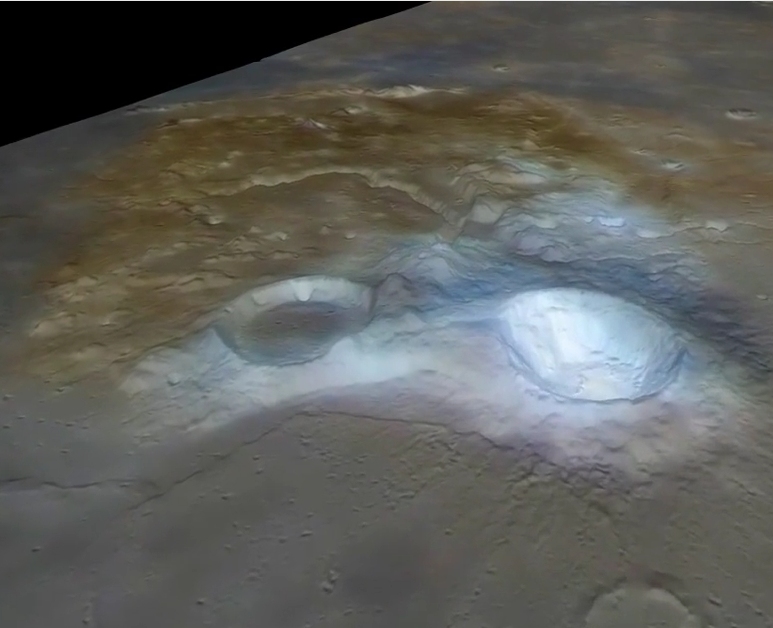
The aforementioned guy created his best flyover video to date, again using his saturation-enhanced telescopic images over a 3D terrain model: www.youtube.com...
I especially like the view of the Aristarchus plateau at 1:13. It's probably the most colourful place on the Moon, its mustard-yellow colouration easily visible through binoculars.

new topics
-
President BIDEN's FBI Raided Donald Trump's Florida Home for OBAMA-NORTH KOREA Documents.
Political Conspiracies: 2 hours ago -
Maestro Benedetto
Literature: 4 hours ago -
Is AI Better Than the Hollywood Elite?
Movies: 4 hours ago -
Las Vegas UFO Spotting Teen Traumatized by Demon Creature in Backyard
Aliens and UFOs: 8 hours ago -
2024 Pigeon Forge Rod Run - On the Strip (Video made for you)
Automotive Discussion: 8 hours ago -
Gaza Terrorists Attack US Humanitarian Pier During Construction
Middle East Issues: 9 hours ago -
The functionality of boldening and italics is clunky and no post char limit warning?
ATS Freshman's Forum: 10 hours ago -
Meadows, Giuliani Among 11 Indicted in Arizona in Latest 2020 Election Subversion Case
Mainstream News: 11 hours ago -
Massachusetts Drag Queen Leads Young Kids in Free Palestine Chant
Social Issues and Civil Unrest: 11 hours ago
top topics
-
President BIDEN's FBI Raided Donald Trump's Florida Home for OBAMA-NORTH KOREA Documents.
Political Conspiracies: 2 hours ago, 23 flags -
Krystalnacht on today's most elite Universities?
Social Issues and Civil Unrest: 14 hours ago, 9 flags -
University of Texas Instantly Shuts Down Anti Israel Protests
Education and Media: 16 hours ago, 8 flags -
Weinstein's conviction overturned
Mainstream News: 12 hours ago, 8 flags -
Supreme Court Oral Arguments 4.25.2024 - Are PRESIDENTS IMMUNE From Later Being Prosecuted.
Above Politics: 14 hours ago, 8 flags -
Massachusetts Drag Queen Leads Young Kids in Free Palestine Chant
Social Issues and Civil Unrest: 11 hours ago, 7 flags -
Gaza Terrorists Attack US Humanitarian Pier During Construction
Middle East Issues: 9 hours ago, 7 flags -
Las Vegas UFO Spotting Teen Traumatized by Demon Creature in Backyard
Aliens and UFOs: 8 hours ago, 6 flags -
Meadows, Giuliani Among 11 Indicted in Arizona in Latest 2020 Election Subversion Case
Mainstream News: 11 hours ago, 5 flags -
2024 Pigeon Forge Rod Run - On the Strip (Video made for you)
Automotive Discussion: 8 hours ago, 4 flags
active topics
-
-@TH3WH17ERABB17- -Q- ---TIME TO SHOW THE WORLD--- -Part- --44--
Dissecting Disinformation • 688 • : daskakik -
Reason of the Existence
The Gray Area • 21 • : BingoMcGoof -
President BIDEN's FBI Raided Donald Trump's Florida Home for OBAMA-NORTH KOREA Documents.
Political Conspiracies • 10 • : nugget1 -
Supreme Court Oral Arguments 4.25.2024 - Are PRESIDENTS IMMUNE From Later Being Prosecuted.
Above Politics • 85 • : Sookiechacha -
Chris Christie Wishes Death Upon Trump and Ramaswamy
Politicians & People • 24 • : nugget1 -
New whistleblower Jason Sands speaks on Twitter Spaces last night.
Aliens and UFOs • 63 • : pianopraze -
SETI chief says US has no evidence for alien technology. 'And we never have'
Aliens and UFOs • 74 • : Justoneman -
Starburst galaxy M82 - Webb Vs Hubble
Space Exploration • 6 • : Arbitrageur -
University of Texas Instantly Shuts Down Anti Israel Protests
Education and Media • 264 • : stelth2 -
VirginOfGrand says hello
Introductions • 9 • : TheMichiganSwampBuck

